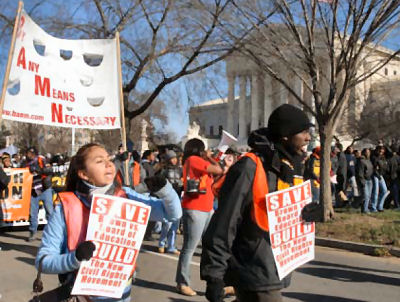
Affirmative Action March in Washington
The Extraordinarily Unlevel Playing Field
Affirmative Action is often accused creating more racial boundaries than it blurs
![]() Loading ...
Loading ...
Affirmative action was first added to many American university’s policies in the late 1960s. A 2003 Supreme Court case Grutter v. Bollinger ruled an unprecedented government policy in support of affirmative action, stating “Student-body diversity is a compelling state interest that can justify the use of race in university admissions.” The belief that affirmative action has a solely positive impact on universities and minorities alike has stuck in people’s minds for generations. However as years pass, and affirmative action research increases, its effects are oftentimes identified as negative.
Most notably, affirmative action is routinely labeled as “legal discrimination,” or systematic racism. In general, affirmative action policies assist Hispanic and black applicants, while penalizing white and Asian-Americans. The 2009 book No Longer Separate, Not Yet Equal insinuates the idea that black students scoring a 1000 on the SAT have a comparatively equal score to hispanics with a score of 1130, whites with a score of 1310, and Asian-Americans with a score of 1450.
Affirmative action has even made national news in 2018 as Asian-Americans began a lawsuit against Harvard University for racial discrimination. The plaintiffs have accused Harvard of using both a discriminatory quota system and “personal score” policy. Harvard’s “personal score” rates students based off characteristics. Asian-Americans regularly received lower scores on features including courage, integrity, and likeability. Former federal prosecutor Shan Wu describes these low scores as “dictionary definition racism.”
So where did the idea that affirmative action being a positive policy come from, and has this belief ever been objectively correct?
In a 1965 address at Howard University, President Lyndon Johnson stated “[T]he task is to give 20 million Negroes the same chance as every other American to learn and grow, to work and share in society, to develop their abilities—physical, mental and spiritual, and to pursue their individual happiness.” Essentially, affirmative action served as compensation in a time where minority groups, specifically African-Americans, likely needed it the most: one of racial segregation, and just 100 years after the abolishment of slavery. At this time, intermarriage was also illegal, yet today one in six Americans intermarry. To admit students based on racial preferences has become increasingly problematic and complex in the modern day, considering many applicants are of mixed race or ethnicity, and the policy regularly prolongs racial stereotypes. Although at one point affirmative action did compensate for racial differences, today it is an outdated practice that hurts more than it helps, and for that reason, it is likely best the government revise its policies towards it.